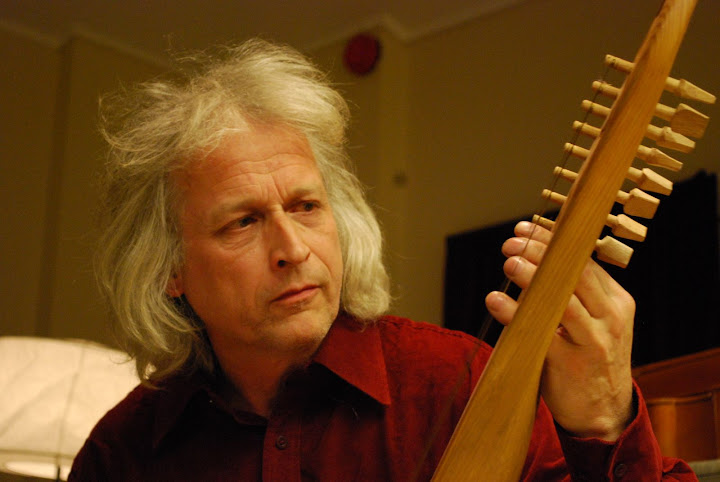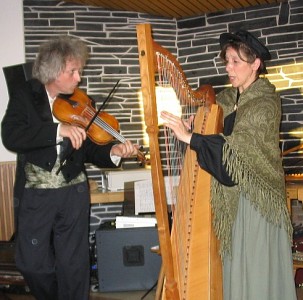Nancy Thym is a famous folklorist, storyteller and harp researcher:
She plays various harps and related stringed instruments, her repertoire ranging from
early music to traditionals, folk and rock'n'roll. At the NHM 2011 in Denmark,
Nancy will present the music of travelling female harpers of the 19th century,
who carried their harps through the world, and earned their living with song
and music in streets, taverns and markets. Music history books are often silent
about these underclass women; nevertheless, they left traces here and there,
and inspired musicians, poets and writers. A detailed interview with one of these
singing harp girls is given in Finlands Almänna Tidning (6th April 1865, page 2).
They introduced chordal accompaniment with "modern" triad harmonies into the soundscape of Finland and influenced
the famous Finnish kantele player Kreeta Haapasalo; they played on markets and
in taverns in Sweden, and Gunnar Wennerberg featured them in his
"Harpospelet på Schylla"; they played also popular songs in the streets of
Copenhagen, e.g. Madame "Harpestine" Schneider, immortalised in the painting by Jens Christian Deichmann (MMCCS nr.OB 84).
The travelling "harp girls" ("Harpepiger") have also left traces in Danish literature:
Hans Christian Andersen was delighted by their music and mentions some of their songs in his diaries,
and the Danish poet Bernhard Severin Ingemann wrote his "Harpepigens klage" after
his encounter with a harp playing orphan from Switzerland in 1814.
In her workshop, Nancy will teach some of the songs which have been performed by these travelling harp ladies.
At the NHM 2010 in Gjøvik, Nancy presented her copy of a
double-soundbox krogharpe from the Westgaard farm in Østerdalen from 1776, with metal
strings and bray pins. She plays this harp "upside down and backwards",
in a position similar to the Siberian and African harps:
With the sound box lying across the player's lap, with the bass strings uppermost,
the pillar being located under the crook of the elbow.
Further information:
Constance Whiteside (2003):
Interview with Nancy Thym. Journal of The Historical Harp Society, Special Double Issue, Fall 2002- Winter 2003. pp. 30-38.
Nancy's website
photo source: Floris van der Meijs

Thilo Viehrig studied instrument building in East Germany and has concentrated
on the performance practise and reconstruction of historical instruments.
This year at the NHM 2011 in Denmark, Thilo will give a lecture about strings on medieval lyres:
The question of appropriate string material is of high relevance for the reconstruction of the
earliest string instruments of the North, such as the Viking Age lyres whose stringless
remains were excavated in Hedeby, Birka and Gotland, and lyres from later periods
such as those whose stringless remains were found in Novgorod, Oslo and Kravik.
Thilo will also demonstrate some of his lyre reconstructions.
At the Nordic Harp Meeting 2010 in Gjøvik, Thilo held a lecture about the
gusli, a lyre-like instrument from medieval Novgorod, its playing technique, history and legends.
The wing-shaped gusli is very similar to the Finnish kantele, Estonian kannel,
Latvian koukles and Lithuanian kankles, and can be played both in kantele style (lying flat)
or in lyre style (held upright and using the window to access strings from behind).


